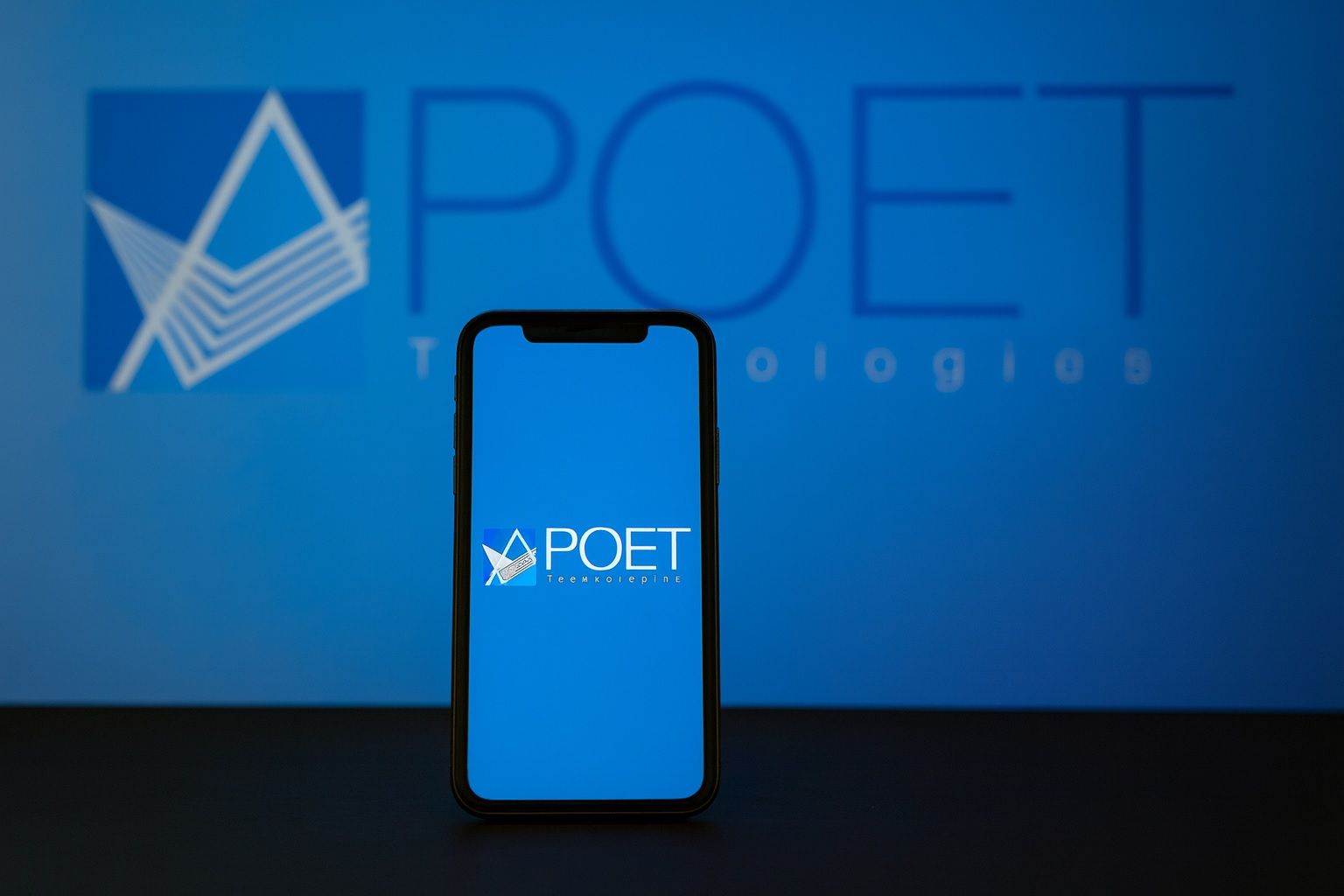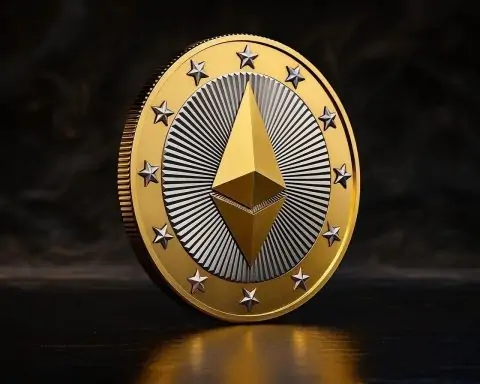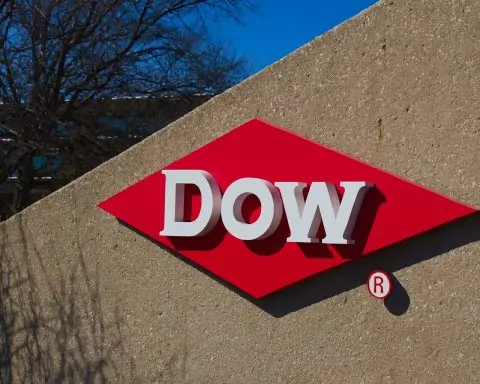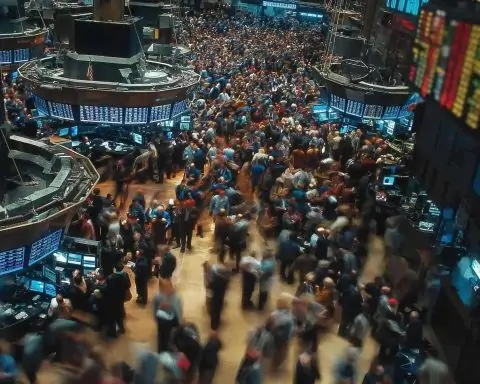- Record Investment: POET Technologies announced a US$75 million private placement on Oct. 7 – the largest single investment in its history – from a single (undisclosed) institutional investor, boosting its cash reserves to over $150 million (with no debt) to expand its AI connectivity business [1] [2].
- Stock Soars: Shares of POET surged to their highest levels in years, jumping 23.5% on Oct 7 to $7.88 (a high last seen in 2022) [3] and climbing further into the ~$9 range on Oct 8. Trading volume hit an astonishing 41 million shares on Oct 7 alone (vs ~2.7 M on an average day) [4] as investors piled in.
- Retail & Options Frenzy:Retail traders fueled the rally with “extremely bullish” sentiment online, and call option bets exploded – about 73,000 calls traded on Oct 7 (≈18× the normal volume), mostly bullish $10 strikes for 2026–27, driving the put/call ratio down to 0.01 [5] [6]. Many traders speculated POET could soon hit $10–$12, reflecting a speculative Reddit/WSB-style fervor around the stock.
- Optical Chip Innovator: POET develops high-speed optical engine chips and light sources for AI systems and data centers using its patented Optical Interposer platform, which integrates photonic devices (like lasers) and electronic circuits on a single chip [7]. These photonic modules enable ultra-fast data links (on the order of 800 Gb/s to 1.6 Tb/s) with lower power and cost, alleviating the data bandwidth bottlenecks that traditional copper connections face in AI supercomputers [8] [9].
- Building Momentum: In late September, POET launched a 1.6-terabit optical receiver module with Semtech for next-gen AI networks [10], and won the “Most Innovative Optical Product” award at ECOC 2025 for its 200G/lane photonic engine platform [11]. It also partnered with Sivers Semiconductors to co-develop external laser modules for future “co-packaged optics” in AI data centers [12] – an emerging segment that analysts peg at over $1 billion annually [13]. Industry experts estimate the broader AI optical connectivity opportunity has already created $50 billion in market value [14].
- High Hopes vs. Reality: Despite the hype, POET remains pre-revenue and unprofitable (trailing net margin ~–11,500% [15]). Its valuation is sky-high (price-to-sales ~1457 [16]), and Wall Street is cautious – the only recent analyst rating is “Hold” with a ~$6.50 price target [17], implying the stock is ahead of fundamentals. POET now must execute – use its new cash to scale production and win customers – to justify investors’ optimism.
$75 Million Infusion Fuels POET’s AI Ambitions
POET Technologies – a small Toronto-based photonic chip designer – just secured a massive $75 million cash infusion to supercharge its growth in the AI hardware arena [18]. Announced on October 7, the deal was structured as a non-brokered private placement of ~13.64 million new shares (plus warrants) with a single institutional investor [19]. “This is the largest single investment in POET’s history,” noted CEO Dr. Suresh Venkatesan, adding that it boosts POET’s balance sheet to over $150 million in cash and no significant debt [20]. The shares were issued at $5.50 (with an accompanying warrant), suggesting the investor bought in at a modest discount but also received upside exposure. The warrants are exercisable at C$9.78 (through 2030) [21] – pricing that implies the backer believes POET’s stock could roughly double in the coming years.
Importantly, the investor’s identity was not disclosed, fueling speculation that it could be a strategic industry player (for instance, a major AI chip or cloud company) rather than a passive fund [22]. Regardless, the capital provides a huge vote of confidence and “war chest” for POET. “The massive growth of AI infrastructure represents an unprecedented opportunity for which POET is well-prepared,” said CEO Venkatesan, noting the firm now has “a war chest of over $150 million in cash and no significant debt” to scale up its growth ambitions in advanced AI hardware [23]. Management plans to deploy the $75 million toward targeted acquisitions, aggressive R&D expansion, and scaling up manufacturing – all focused on POET’s core mission of enabling next-generation AI connectivity solutions [24]. In Venkatesan’s words, the funds will help POET “secure our technological lead and revenue generating opportunities in light sources for chip-to-chip connectivity, ultra high-speed transceivers and related applications.” [25] In short, this cash injection solidifies POET’s finances to pursue growth “without the overhang of debt or near-term funding needs,” as one industry observer noted [26].
Optical Engines to Tackle AI’s Data Bottleneck
POET’s value proposition centers on a pressing bottleneck in AI computing: moving huge volumes of data between chips (like GPUs and TPUs) efficiently. Today’s AI models and datasets are so massive that traditional copper interconnects inside servers can’t keep up – they hit bandwidth and power limits over short distances [27]. This has made optical interconnects – using light instead of electrical signals – a critical technology to sustain the AI boom. Fibre-optic links have long been used between data centers; POET is bringing that speed onto the chips and inside the data center.
The company’s patented POET Optical Interposer™ is a silicon photonics platform that seamlessly integrates photonic devices (lasers, modulators, etc.) and electronic circuits together on one chip [28]. In essence, POET can create tiny “optical engine” modules – chip-scale transceivers that send and receive data as pulses of light – with unprecedented integration and cost-efficiency. According to the company, its interposer-based optical products are smaller, cheaper, and more power-efficient than conventional designs, and can be mass-produced using standard semiconductor processes [29] [30]. These photonic engines target the most demanding data links in next-gen computing: on the order of 800 Gbps to 1.6 Tbps between AI accelerators and across high-performance data centers [31]. For example, POET has developed novel optical light source modules for chip-to-chip communication within AI server racks – essentially optical replacements for short copper cables – to slash latency and energy use [32]. This capability is “the next frontier for solving bandwidth and latency problems in AI systems,” the company explains [33]. By embedding ultra-high-speed photonics at the chip and rack level, AI clusters can dramatically increase throughput between processors, preventing the data bottlenecks that slow down training of large machine learning models [34]. Industry experts widely agree that optical connectivity is key to scaling AI infrastructure, as even tech giants are racing to upgrade networks to 800G/1.6T speeds while cutting power per bit [35]. In this context, POET’s technology is timely – a convergence of photonics and AI demand, where enormous market value is at stake [36].
Partnerships, Products and Industry Buzz
POET isn’t trying to go it alone. The company has been rapidly rolling out new products and forging partnerships to capitalize on surging demand for AI connectivity. In late September 2025 – just days before the funding – POET and Semtech Corp. jointly launched a 1.6-terabit-per-second optical receiver module for AI data centers [37]. This module (now sampling to customers) combines Semtech’s latest 200 Gbps-per-lane receiver ASICs with POET’s interposer in one compact package. It supports both 8×200G short-reach (DR8) links (within AI superclusters) and 2×FR4 long-reach links (between data center racks) [38]. The design boasts lower power consumption and high signal integrity at 200G/lane, showcasing how POET can partner with larger chipmakers to bring cutting-edge optical engines to market quickly [39].
Around the same time, POET earned prestigious recognition on the global stage. It won the “Most Innovative Chip-Scale Optical Product” award at the ECOC 2025 conference – Europe’s top optical communications event – for its 200 G/lane Optical Interposer engine technology [40]. Notably, this was POET’s seventh industry award in 15 months [41], underlining a pattern of innovation that’s gaining credibility even among an industry dominated by far larger incumbents. Such accolades from independent experts signal that POET’s solutions are seen as genuinely leading-edge [42], helping validate its approach in the eyes of customers and investors.
Another strategic move came via POET’s collaboration with Sweden’s Sivers Semiconductors. On Sept. 29, POET and Sivers announced a partnership to co-develop external light source (ELS) modules for co-packaged optics – an emerging architecture for next-gen AI and networking hardware [43]. This effort will marry Sivers’ high-power semiconductor lasers with POET’s interposer platform to create laser modules that sit alongside switch or accelerator chips (“co-packaged”) in future AI systems [44]. The goal is to deliver efficient, integrated laser light sources produced at wafer-scale, addressing a critical need as AI clusters scale up. Analysts are bullish on this area: Northland Capital’s Tim Savageaux projects that co-packaged optics and external laser modules represent a $1 billion+ annual opportunity, as part of a broader $50 billion AI optical connectivity market today [45] [46]. “We estimate that the AI optical connectivity opportunity has created over $50 Billion in market value to date,” notes Savageaux, who pegs the new ELS segment at a “$1 B+ annual market.” [47] The POET–Sivers team expects to demo early prototypes in 1H 2026 and aim for production by late 2026 [48] – aligning with when many in the industry predict co-packaged optics will begin real-world deployment. If successful, this partnership could position POET as a key supplier of the “laser engines” inside future AI switches and servers, complementing its optical transceiver products [49].
All told, POET spent early fall 2025 aggressively expanding its footprint across the optical interconnect value chain – from ultra-fast receiver engines (Semtech deal) to high-power light sources (Sivers deal) – while garnering significant industry validation (ECOC award) along the way [50] [51]. This flurry of announcements coincided with major photonics conferences (ECOC in Europe, CIOE in Asia) where companies often unveil breakthroughs [52]. The well-timed news likely helped stoke investor interest and set the stage for the $75 million investment that soon followed, by demonstrating that POET is actively executing on its vision [53].
Stock Market Euphoria – and Volatility
The convergence of a big funding win and POET’s AI photonics story unleashed a wave of excitement in POET’s stock – along with a dose of volatility. On news of the $75M deal, POET’s NASDAQ-listed shares rocketed to multi-year highs. The stock jumped 23.5% on Oct. 7 to close at $7.88 (its highest in about 3½ years) [54], then climbed further to $8.50 in after-hours trading, logging roughly a 33% single-day gain including the after-market pop [55]. Momentum carried into the next session: by Oct. 8 the stock approached the $9 mark, capping an extraordinary two-day run. Year-to-date, POET was up over 70% after this surge (nearly doubling from its levels six months prior) [56], giving the tiny company a market capitalization around ~$700 million.
Trading activity was frenzied. Volume on Oct. 7 exceeded 41 million shares, 15 times higher than the prior day and vastly above POET’s ~2.7 million daily average [57]. This is an unusually large turnover considering the company’s float, indicating heavy retail trader involvement. In fact, POET became a trending ticker on social platforms. On Stocktwits (a popular retail trading forum), sentiment spiked to 91/100 (“extremely bullish”) as of Oct. 7–8, and message volume jumped from “high” to “extremely high” [58]. POET was the third most-mentioned ticker at one point. Many users were giddy about the news and speculated the stock could soon breach $10 or even $12 [59]. This kind of chatter – reminiscent of Reddit’s WallStreetBets style optimism – underscores the speculative fervor that gripped POET’s stock following the announcement.
Perhaps the clearest sign of exuberance came from the options market. On Oct. 7 alone, traders snapped up an estimated 73,000+ call options on POET – about 18× the normal volume – largely targeting out-of-the-money $10 strike calls expiring in 2026–27 [60]. This aggressive call buying indicates bets that POET’s share price (which was ~$5–6 before the news) could double or more in the next 1–2 years. Correspondingly, the put/call ratio plummeted to 0.01 [61] – meaning virtually all options activity was bullish. Such extreme readings are rare and typically short-lived, often occurring when speculators rush in after a catalytic event. It suggests a lot of short-term traders are trying to ride the wave, expecting that new cash and partnership prospects might propel the stock even higher. Indeed, social media buzz speculated about the “mystery investor” and the possibility of a big strategic partner behind the scenes, adding to the FOMO (fear of missing out) among retail participants [62].
It’s worth noting that POET’s stock had seen pops before – for instance, last month it jumped 15% in one day after announcing a mere $500k customer order [63] – but the scale of this week’s move and volume was unprecedented for the company. The involvement of retail trading momentum can cut both ways: rapid gains but also potential for sharp reversals if sentiment shifts. In the near term, volatility is likely to remain high as the market digests the news and awaits further clues about the mysterious investor and POET’s next moves.
Big Opportunity, Big Challenges Ahead
Amid the excitement, seasoned analysts and industry observers are urging caution on POET. For all its promise, POET Technologies is still essentially an early-stage, pre-commercial company. It has very minimal revenues to date and has operated at a loss for years while developing its products [64]. By traditional metrics, the stock’s valuation is extremely stretched. For perspective, POET’s trailing 12-month net profit margin is around –11,500% (reflecting tiny sales against ongoing R&D expenses) and its price-to-sales ratio is on the order of 1457 [65]. These eye-popping figures simply underscore that POET’s current revenue base is almost negligible – so investors are pricing in high expectations of future growth. Such numbers are not unusual for a nascent deep-tech hardware firm, but they highlight that POET must execute flawlessly (ramp up production and win customers) to justify the recent valuation spike [66].
Wall Street’s outlook remains measured. The consensus rating on POET is only “Hold,” and the sole published analyst price target is about $6.50 [67] – roughly where the stock was trading before the latest spike. In other words, professional analysts currently see the stock as fully valued at best, pending more evidence of commercial traction. TipRanks’ AI-based stock analysis likewise notes POET’s poor financials and rich valuation, despite acknowledging its recent momentum [68]. That said, the recent $75M investment could signal something beyond just cash – if the investor is revealed as a strategic partner (say, a larger semiconductor or cloud company), it would hint at industry validation that might merit a re-rating. Conversely, if it’s purely a financial investor, POET still needs to prove itself through revenue growth and customer wins to earn its market cap [69].
Ultimately, the next 12–24 months will be pivotal for POET Technologies. The company now has over $150 million in the bank and no debt, giving it the runway to scale manufacturing, refine its optical engine products, and court major customers in the AI/datacenter space [70]. Its technology has garnered critical acclaim and clearly addresses a real pain point in AI infrastructure. The open question is whether POET can convert this technological promise into significant commercial success. If POET’s optical interconnect solutions start getting designed into mainstream AI training clusters or adopted by hyperscale data center operators, the upside could be substantial. If not – if deployments falter or competition overtakes – the current valuation would be hard to sustain.
For now, POET has bought itself time and resources to execute on its vision. The exploding AI hardware market is, as CEO Venkatesan described, an “unprecedented opportunity” – now it’s up to POET to turn that opportunity into tangible results [71]. The market will be watching closely. After all, $75 million of new confidence – and a hefty dose of expectations – are riding on this tiny optical chipmaker’s next moves.
Sources: Press release [72] [73]; Tech industry news (TechSpace 2.0) [74] [75]; Stocktwits News [76] [77]; Benzinga [78] [79]; Investing.com [80] [81]; Company filings and analyst commentary [82] [83].
References
1. ts2.tech, 2. ts2.tech, 3. stocktwits.com, 4. ts2.tech, 5. ts2.tech, 6. stocktwits.com, 7. ts2.tech, 8. ts2.tech, 9. ts2.tech, 10. ts2.tech, 11. ts2.tech, 12. ts2.tech, 13. ts2.tech, 14. ts2.tech, 15. ts2.tech, 16. ts2.tech, 17. ts2.tech, 18. ts2.tech, 19. ts2.tech, 20. ts2.tech, 21. ts2.tech, 22. ts2.tech, 23. www.globenewswire.com, 24. ts2.tech, 25. ts2.tech, 26. ts2.tech, 27. ts2.tech, 28. ts2.tech, 29. ts2.tech, 30. ts2.tech, 31. ts2.tech, 32. ts2.tech, 33. ts2.tech, 34. ts2.tech, 35. ts2.tech, 36. ts2.tech, 37. ts2.tech, 38. ts2.tech, 39. ts2.tech, 40. ts2.tech, 41. ts2.tech, 42. ts2.tech, 43. ts2.tech, 44. ts2.tech, 45. ts2.tech, 46. ts2.tech, 47. ts2.tech, 48. ts2.tech, 49. ts2.tech, 50. ts2.tech, 51. ts2.tech, 52. ts2.tech, 53. ts2.tech, 54. stocktwits.com, 55. ts2.tech, 56. ts2.tech, 57. ts2.tech, 58. stocktwits.com, 59. stocktwits.com, 60. ts2.tech, 61. ts2.tech, 62. ts2.tech, 63. stocktwits.com, 64. ts2.tech, 65. ts2.tech, 66. ts2.tech, 67. ts2.tech, 68. ts2.tech, 69. ts2.tech, 70. ts2.tech, 71. ts2.tech, 72. www.globenewswire.com, 73. ts2.tech, 74. ts2.tech, 75. ts2.tech, 76. stocktwits.com, 77. stocktwits.com, 78. ts2.tech, 79. ts2.tech, 80. www.investing.com, 81. www.investing.com, 82. ts2.tech, 83. ts2.tech










